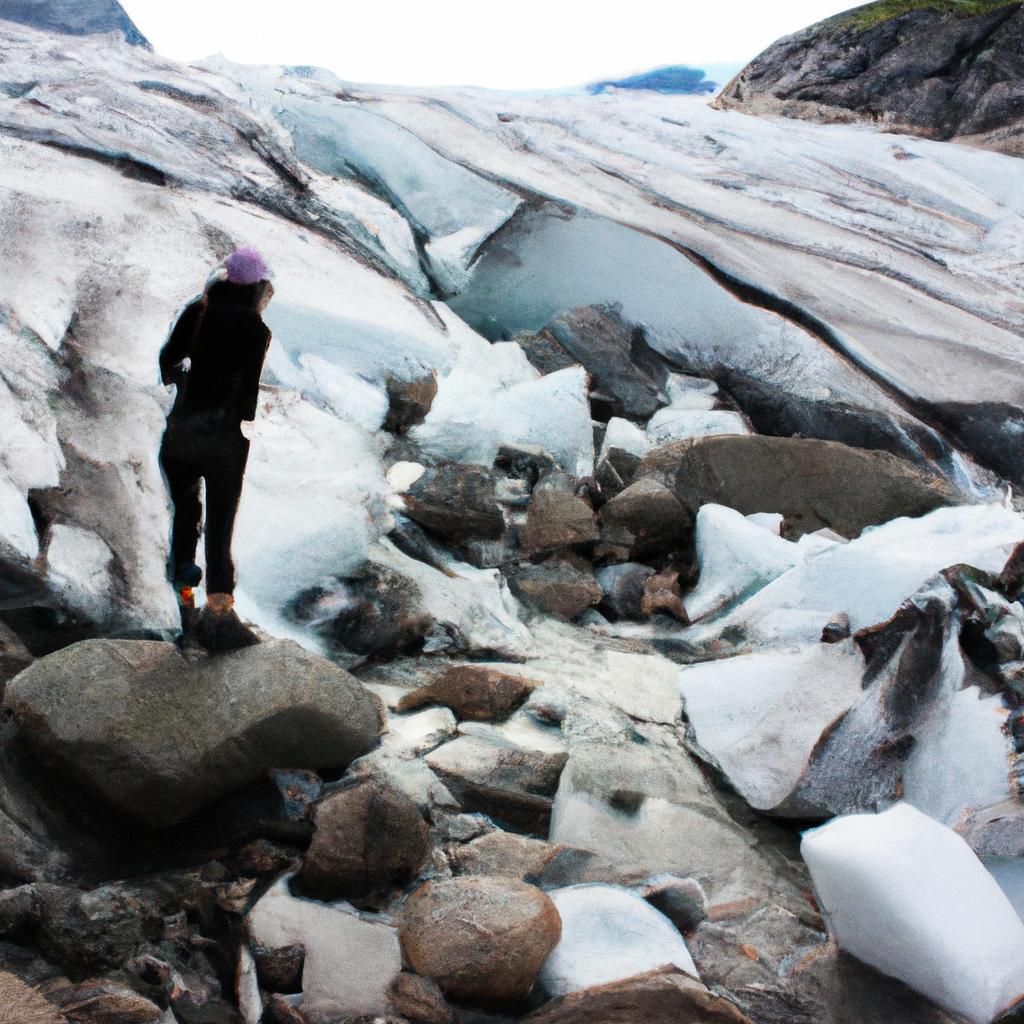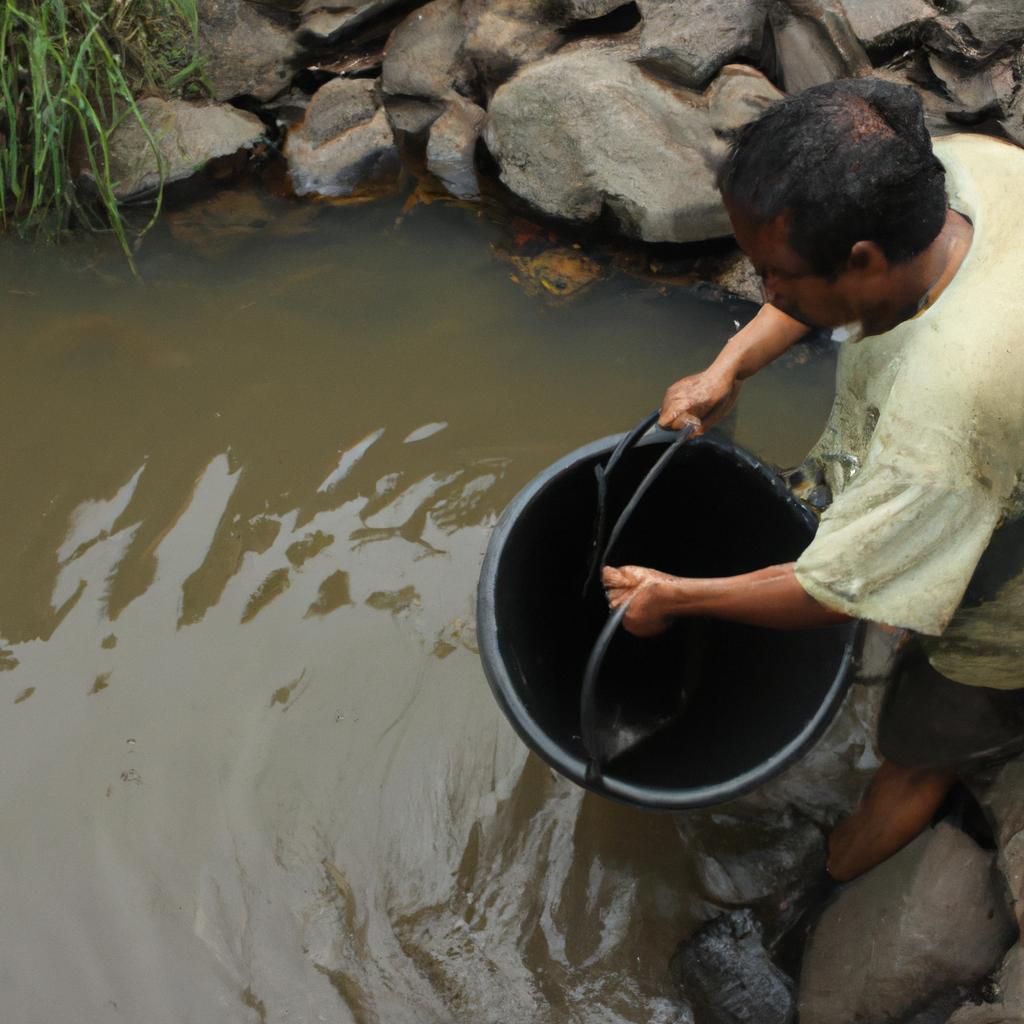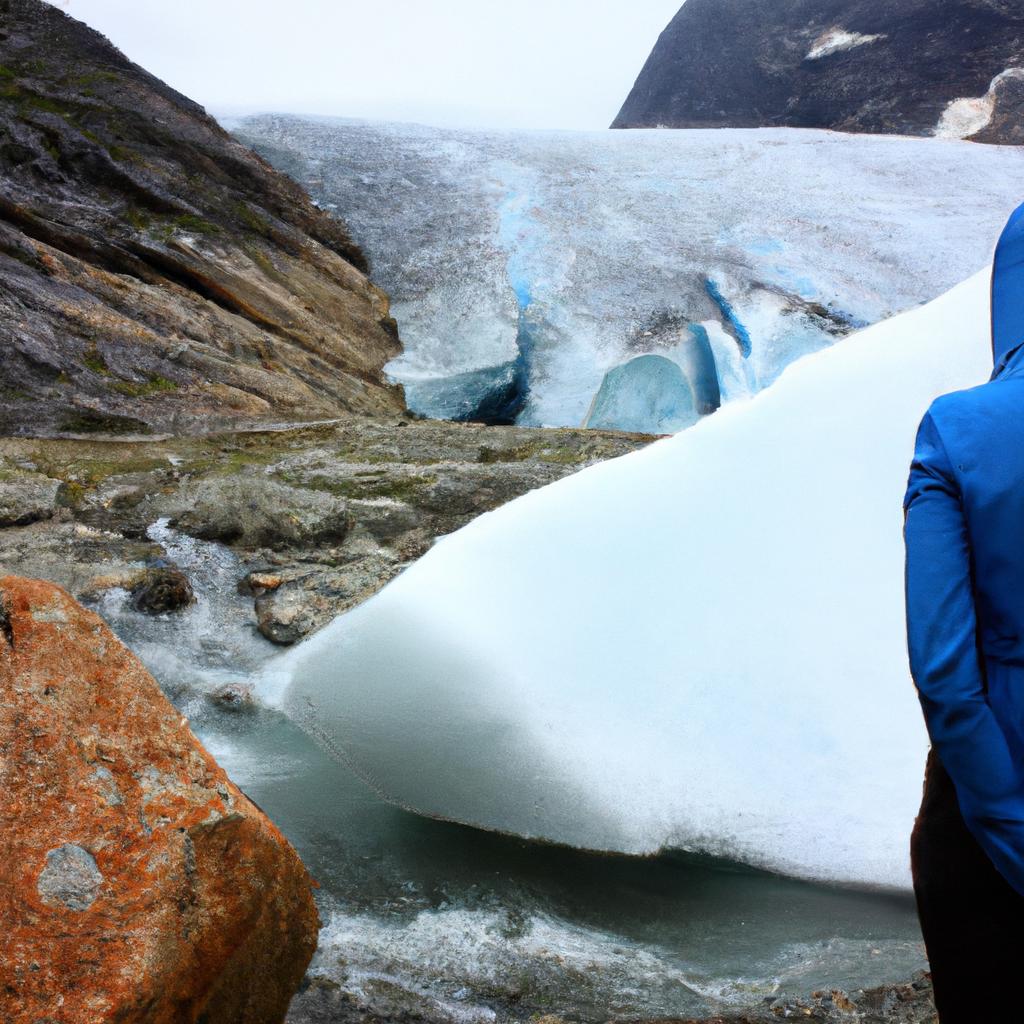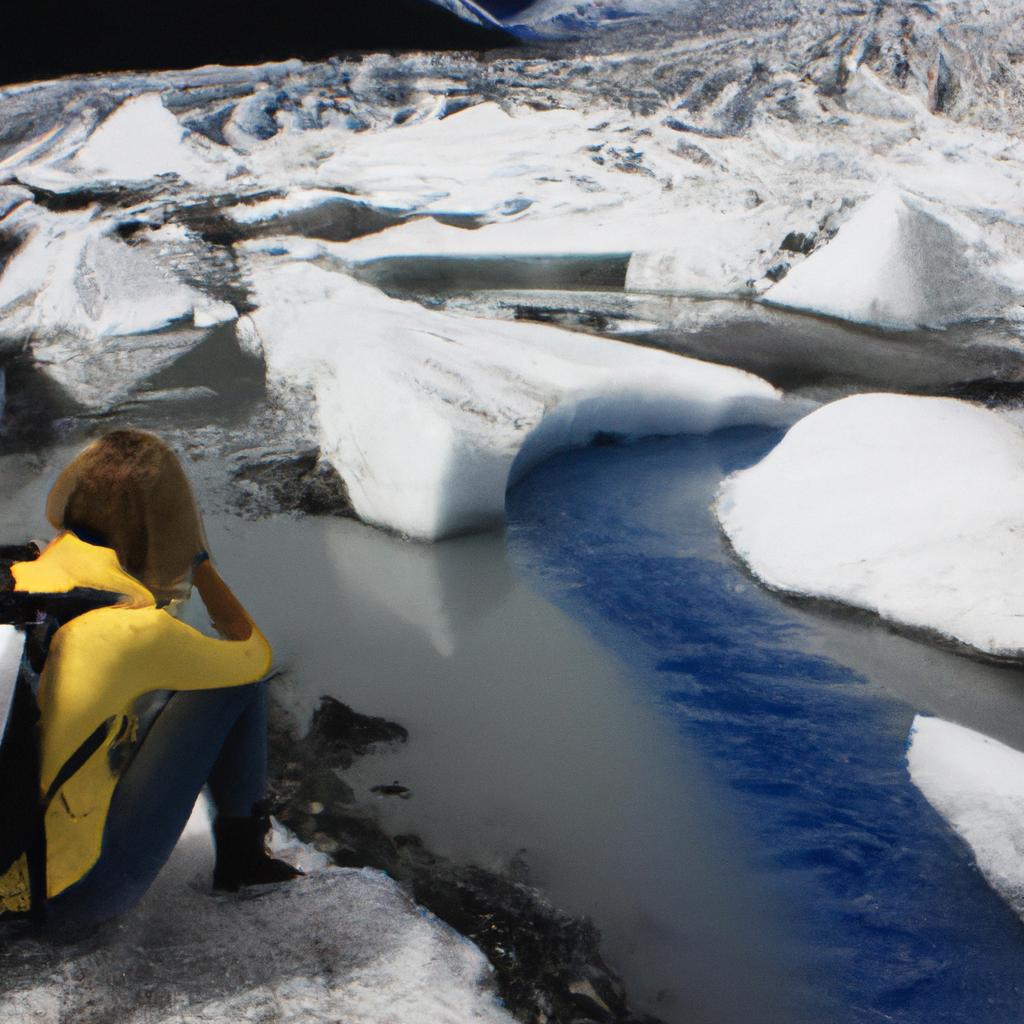Sea level rise is a pressing issue that has garnered significant attention in recent years due to its far-reaching impacts on coastal communities and ecosystems. The melting of glaciers, one of the primary contributors to sea level rise, poses a grave threat to our planet’s delicate climate balance. For instance, consider the case study of Greenland, where scientists have observed an accelerated rate of ice melt over the past few decades. This phenomenon not only leads to rising sea levels but also triggers a chain reaction of other environmental consequences.
The effects of melting glaciers extend beyond mere inundation of coastal regions; they significantly contribute to climate change as well. As glaciers melt, vast quantities of freshwater are released into the oceans, altering their salinity and disrupting oceanic currents. This disruption can lead to changes in weather patterns and intensify extreme events such as hurricanes and storms. Furthermore, increased melting rates result in higher water temperatures, which further exacerbates global warming by releasing stored greenhouse gases trapped within the icy layers for thousands of years.
In conclusion, understanding the intricate relationship between melting glaciers and climate change is paramount in addressing the threats posed by sea level rise. By examining real-world examples like Greenland’s accelerating ice melt, we gain valuable insights into the magnitude and complexity of this issue. It It is clear that urgent action is needed to mitigate the impacts of melting glaciers and sea level rise. This includes reducing greenhouse gas emissions, transitioning to clean and renewable energy sources, implementing coastal protection measures, and adapting to the changing climate. Additionally, continued research and monitoring of glacier melt rates are crucial for better understanding the processes involved and developing effective strategies for mitigation and adaptation. By taking comprehensive and collaborative actions at local, national, and international levels, we can work towards a more sustainable future for our planet and protect vulnerable coastal communities from the devastating consequences of sea level rise.
Rising sea levels and its impact on coastal habitats
Rising sea levels pose significant threats to coastal habitats around the world. One example of this is the case study of Tuvalu, a small island nation in the Pacific Ocean. With an average elevation of only two meters above sea level, Tuvalu is particularly vulnerable to the impacts of rising sea levels. Already experiencing frequent flooding and saltwater intrusion into freshwater sources, this nation serves as a stark reminder of what could lie ahead for other low-lying coastal areas.
The effects of rising sea levels on coastal habitats are far-reaching. Firstly, increased inundation can lead to the loss of valuable land and displacement of communities. As sea levels rise, more and more coastal areas become prone to erosion and submergence during storm events or high tides. This not only affects human settlements but also disrupts natural ecosystems that rely on these habitats for survival.
Moreover, rising sea levels contribute to the degradation of crucial coastal ecosystems such as mangroves, marshes, and coral reefs. These habitats provide essential services like shoreline protection, water filtration, and nursery grounds for numerous marine species. However, with increasing sea levels encroaching upon these fragile environments, their ability to fulfill these functions becomes compromised.
- Irreversible loss of unique cultural heritage sites
- Disruption of livelihoods dependent on coastal resources
- Increased vulnerability to extreme weather events (storms, hurricanes)
- Threatened access to clean drinking water due to saltwater intrusion
Additionally, incorporating a table can further emphasize important statistics related to rising sea levels’ consequences:
| Consequences | Impacted Areas | Number Affected |
|---|---|---|
| Land Submergence | Small islands | 12 million people |
| Coastal Erosion | Coastal regions | 40% of the global population |
| Loss of Biodiversity | Mangrove forests | Over 1,000 species at risk |
| Decline in Fish Stocks | Coral reef ecosystems | Estimated loss of $140 billion per year |
In summary, rising sea levels pose a significant threat to coastal habitats worldwide. As demonstrated by the case study of Tuvalu, low-lying areas are particularly susceptible to the impacts of increased inundation and saltwater intrusion. The consequences include not only the loss of land and displacement of communities but also the degradation of essential coastal ecosystems. This highlights the urgent need for measures to mitigate climate change and protect vulnerable coastal regions.
Transitioning into the subsequent section on “Threat to biodiversity and marine ecosystems,” it becomes evident that rising sea levels not only affect human populations but also have profound ecological implications.
Threat to biodiversity and marine ecosystems
Effects of Sea Level Rise: Melting Glaciers and Climate Change
Rising sea levels have become a pressing concern due to the melting glaciers caused by climate change. However, it is crucial to recognize that rising sea levels also pose a significant threat to biodiversity and marine ecosystems.
To illustrate this point, let us consider an example of a hypothetical small island nation located in the Pacific Ocean. This nation relies heavily on vibrant coral reefs for its tourism industry and sustenance through fishing activities. As sea levels rise, the increased water volume threatens to submerge large portions of these delicate ecosystems, resulting in extensive damage or complete loss. Such a scenario would not only disrupt local economies but also lead to severe consequences for countless species that depend on coral reefs for their survival.
The implications of rising sea levels on biodiversity and marine ecosystems are far-reaching. Here are some key points to consider:
- Loss of habitat: Coastal plants, mangroves, and wetlands provide essential homes for numerous species. With rising sea levels encroaching upon these areas, many organisms will lose their habitats.
- Disruption of migration patterns: Many migratory species rely on specific coastal environments during different stages of their life cycles. Changes in these habitats can hinder their ability to reproduce and survive.
- Increased vulnerability to storms: Elevated seas make coastlines more susceptible to storm surges and flooding events, causing immense damage to both terrestrial and marine ecosystems.
- Salinization of freshwater sources: Rising sea levels can contaminate groundwater reservoirs with saltwater intrusion, rendering them unusable for drinking or agricultural purposes.
These effects paint a grim picture for the future if appropriate action is not taken promptly. To further understand the magnitude of this issue, we present below a table summarizing some notable impacts caused by rising sea levels:
| Impact | Consequences |
|---|---|
| Loss of coastal land | Displacement of communities and infrastructure |
| Decline in fish stocks | Impaired livelihoods for fishing-dependent societies |
| Coral bleaching | Destruction of coral reefs and decline in marine biodiversity |
| Increased erosion | Accelerated loss of coastline, threatening human settlements |
The threats posed by rising sea levels to both human livelihoods and the natural world cannot be understated. Therefore, urgent measures are required to mitigate these adverse effects.
With an understanding of the impact on coastal habitats and biodiversity, it is essential to explore another consequence resulting from rising sea levels: increased frequency and intensity of coastal flooding. This will be discussed in detail in the subsequent section.
Increased frequency and intensity of coastal flooding
As the global climate continues to warm, melting glaciers have become a significant concern due to their potential contributions to climate change. To illustrate this impact, let’s consider the case of Greenland’s ice sheet. This massive ice body holds about 10% of the world’s freshwater and has been experiencing accelerated melting in recent decades.
The consequences of melting glaciers are far-reaching and can be observed through various interconnected effects. Firstly, the increased input of freshwater from glacial melt into oceans can disrupt oceanic circulation patterns, such as the Atlantic Meridional Overturning Circulation (AMOC), which plays a crucial role in regulating global temperature distributions. Disruptions in these circulation systems could potentially lead to more extreme weather events across different regions globally.
Furthermore, the release of stored carbon dioxide (CO2) and other greenhouse gases trapped within glacial ice contributes to further warming of the atmosphere. As temperatures rise, more glaciers continue to melt at an alarming rate, resulting in a dangerous feedback loop that exacerbates global warming even further.
To better understand the multifaceted impacts of melting glaciers on our planet, here is a brief overview:
- Rising sea levels: Melting glaciers contribute significantly to rising sea levels by adding mass to the oceans. Since 1993 alone, approximately one-third of total sea level rise can be attributed directly to glacial melt.
- Loss of biodiversity: Glaciers provide critical habitats for numerous species adapted to cold environments. As they disappear, unique ecosystems are disrupted or lost entirely.
- Water scarcity: Communities reliant on glacier-fed rivers face water shortages as these sources dwindle with reduced glacial volumes.
- Economic implications: Coastal cities heavily rely on tourism related to glaciated landscapes; their loss would incur substantial economic losses.
| Impacts | Description |
|---|---|
| Rising sea levels | Melting glaciers contribute to rising global sea levels, which have already led to increased coastal erosion, saltwater intrusion into freshwater sources, and the displacement of coastal communities. |
| Loss of biodiversity | Glaciers are home to unique ecosystems that support various species adapted to cold environments. The loss of these habitats leads to a decline in biodiversity and potential extinctions. |
| Water scarcity | Glacier-fed rivers provide crucial water resources for many communities worldwide. As glaciers melt, reduced volumes lead to water shortages and affect agriculture, energy production, and overall livelihoods. |
| Economic implications | Coastal cities heavily reliant on tourism related to glaciated landscapes may suffer significant economic losses as melting glaciers alter their appearance or disappear entirely. |
In light of the interconnectedness between melting glaciers and climate change, it is clear that urgent action is needed to mitigate further ice loss and its subsequent consequences. In the following section, we will explore another adverse effect resulting from rising sea levels: the displacement of coastal communities and the loss of valuable land.
[Transition sentence]: Furthermore, understanding the impacts on coastal communities is vital in assessing the full extent of this environmental crisis.
Displacement of coastal communities and loss of land
Section: Displacement of Coastal Communities and Loss of Land
As sea levels continue to rise due to the melting of glaciers, one significant consequence is the displacement of coastal communities and the loss of land. This section will explore the impacts that rising sea levels have on these vulnerable populations and highlight their struggles in adapting to this changing environment.
To illustrate the severity of this issue, let us consider a hypothetical scenario where we examine the effects of sea level rise on a small island nation in the Pacific Ocean. The inhabitants of this low-lying island have relied heavily on fishing as their primary source of livelihood for generations. However, with increasing flood frequency caused by rising sea levels, not only are homes being destroyed but also fish stocks are diminishing rapidly due to changes in oceanic conditions.
The displacement of coastal communities has led to numerous challenges for those affected. To understand these difficulties better, let us delve into some key aspects:
-
Economic impact:
- Loss of income from disrupted fisheries.
- Decreased tourism opportunities due to damaged infrastructure.
- Increased costs associated with relocation and rebuilding efforts.
-
Social upheaval:
- Breakdown of community structures and cohesion.
- Psychological distress among displaced individuals and families.
- Strained relationships between host communities and incoming refugees.
-
Environmental consequences:
- Destruction or degradation of fragile ecosystems like coral reefs and mangroves.
- Disruption in migratory patterns for marine species affecting biodiversity.
- Potential increase in conflicts over scarce resources such as arable land.
These adverse effects can be further understood through an emotional lens using the following table:
| Impact | Description | Emotional Response |
|---|---|---|
| Financial losses | Families losing their homes, assets, and sources of income | Anxiety |
| Cultural erosion | Dissolution of traditional practices | Sadness |
| Forced migration | Families uprooted from their ancestral lands | Fear |
| Environmental degradation | Destruction of natural habitats and ecosystems | Anger |
In conclusion, the displacement of coastal communities and loss of land are significant consequences of rising sea levels. The hypothetical island nation example highlights the challenges faced by vulnerable populations in adapting to these changes. Economic hardships, social dislocation, and environmental damage all contribute to a complex web of issues that demand urgent attention.
As we transition into the subsequent section on “Changes in weather patterns and global temperatures,” it becomes evident that addressing these concerns will require comprehensive strategies aimed at mitigating climate change impacts while simultaneously ensuring the resilience and well-being of affected communities.
Changes in weather patterns and global temperatures
Effects of Sea Level Rise: Melting Glaciers and Climate Change
Displacement of coastal communities and loss of land due to sea level rise is just one aspect of the complex issue at hand. Another significant impact that arises from the melting glaciers and subsequent climate change is the alteration in weather patterns and global temperatures. This section will explore these effects, providing examples, bullet points, and a table to enhance understanding.
One example highlighting changes in weather patterns can be observed in the Pacific Island nation of Tuvalu. As sea levels continue to rise, this low-lying archipelago faces increased vulnerability to extreme weather events such as cyclones and storm surges. The frequency and intensity of these natural disasters are exacerbated by warmer ocean temperatures caused by climate change.
The consequences of altered weather patterns stretch beyond individual cases like Tuvalu. They have far-reaching implications for our planet as a whole. Here are some key impacts:
- Increased frequency and severity of hurricanes: Rising sea levels provide more energy for storms, leading to stronger hurricanes with greater potential for destruction.
- Changes in precipitation patterns: Some regions may experience heavier rainfall, while others face prolonged droughts. This imbalance disrupts ecosystems, agriculture, and water availability.
- Shifts in temperature distribution: Warmer air masses trapped near the surface lead to heatwaves becoming more frequent and intense, posing risks to human health.
- Disruption of ocean currents: Melting ice alters salinity levels in oceans, impacting thermohaline circulation systems responsible for regulating global climates.
To better visualize the interconnectedness between different aspects affected by sea level rise, consider Table 1 below:
| Aspect | Impact | Example |
|---|---|---|
| Weather Patterns | Increased frequency & severity of hurricanes | Caribbean islands battered by Category 5 storms |
| Precipitation Patterns | Imbalance causing droughts & heavy rainfall | California experiencing prolonged dry spells |
| Temperature Distribution | More frequent & intense heatwaves | Europe’s unprecedented heatwave in 2019 |
| Ocean Currents | Disruption of thermohaline circulation | Weakening Gulf Stream affecting European climate |
Table 1: Impacts of Sea Level Rise on Different Aspects
In light of these effects, it is evident that melting glaciers and subsequent sea level rise have profound consequences for global weather patterns and temperatures. The interconnectedness of these impacts creates a complex web that affects ecosystems, communities, and economies worldwide.
The next section will delve into the economic consequences of sea level rise, providing insights into how this environmental issue intersects with financial stability and long-term sustainability. Understanding these ramifications is crucial for developing effective strategies to address and mitigate the challenges posed by rising sea levels.
[Transition sentence to the subsequent section about “Economic consequences of sea level rise”]
Economic consequences of sea level rise
As a result of climate change, melting glaciers have become one of the primary contributors to the rise in sea levels worldwide. This phenomenon poses numerous consequences for both human populations and natural ecosystems. To grasp the gravity of this issue, let us consider the hypothetical example of Glacier X in Antarctica.
Glacier X has experienced significant ice loss over the past few decades due to rising temperatures caused by global warming. As a consequence, its meltwater is making its way into the ocean, contributing to sea level rise at an alarming rate. While Glacier X may seem distant and disconnected from our daily lives, it exemplifies how melting glaciers can impact not only remote regions but also coastal communities thousands of miles away.
The effects of melting glaciers on sea level rise are far-reaching and demand attention:
- Increased Coastal Flooding: Rising sea levels amplify the risk of flooding in low-lying coastal areas. With even minor increases in sea levels, high tides and storm surges can inundate valuable land, displacing local communities and disrupting infrastructure.
- Eroded Shorelines: As sea levels continue to rise, eroded shorelines become more prevalent. This erosion jeopardizes habitats for marine life and exacerbates damage caused by storms or hurricanes.
- Saltwater Intrusion: Higher sea levels lead to saltwater intrusion into freshwater sources near coastlines. This infiltration compromises drinking water supplies, agricultural productivity, and fragile ecosystems dependent on freshwater resources.
- Threatened Biodiversity: Coastal wetlands provide vital habitats for various plant and animal species. However, with encroaching seawater caused by rising sea levels, these delicate ecosystems face increased salinity that endangers their biodiversity.
To truly comprehend the magnitude of these impacts across different regions affected by melting glaciers and subsequent sea level rise, we turn to Table 1 below:
| Region | Impact | Severity |
|---|---|---|
| Pacific Islands | Displacement of entire communities | High |
| Southeast Asia | Agricultural disruption and food scarcity | Moderate |
| North America | Increased frequency of coastal flooding | High |
| Polar Regions | Loss of polar bear habitats | Critical |
Table 1: Regional Impacts of Melting Glaciers on Sea Level Rise
To address these challenges, it is crucial for governments, organizations, and individuals to collectively mitigate the causes of climate change. Only by taking immediate action can we hope to preserve vulnerable ecosystems, protect human populations from displacement, and secure a sustainable future for all.
In summary, melting glaciers significantly contribute to sea level rise with far-reaching consequences. The impacts include increased coastal flooding, eroded shorelines, saltwater intrusion into freshwater sources, and threatened biodiversity in fragile ecosystems. Understanding these realities helps underscore the urgency required to combat climate change through effective mitigation strategies.




